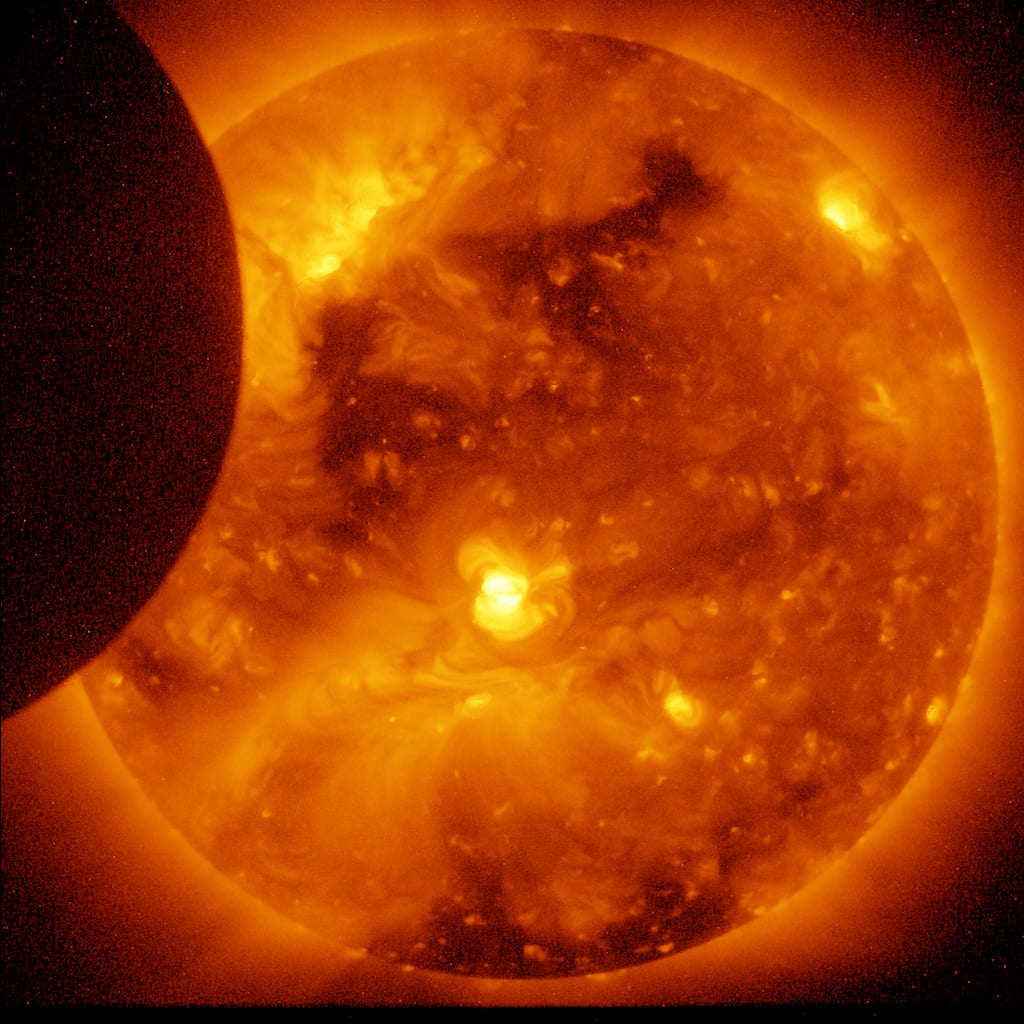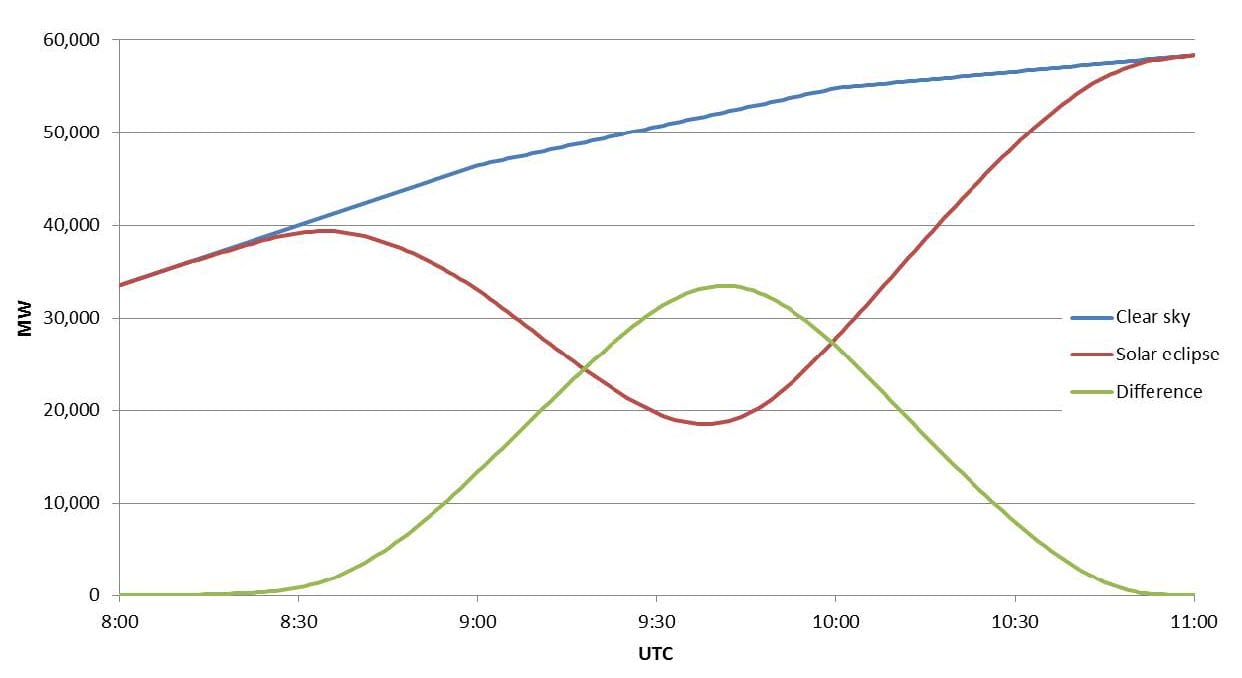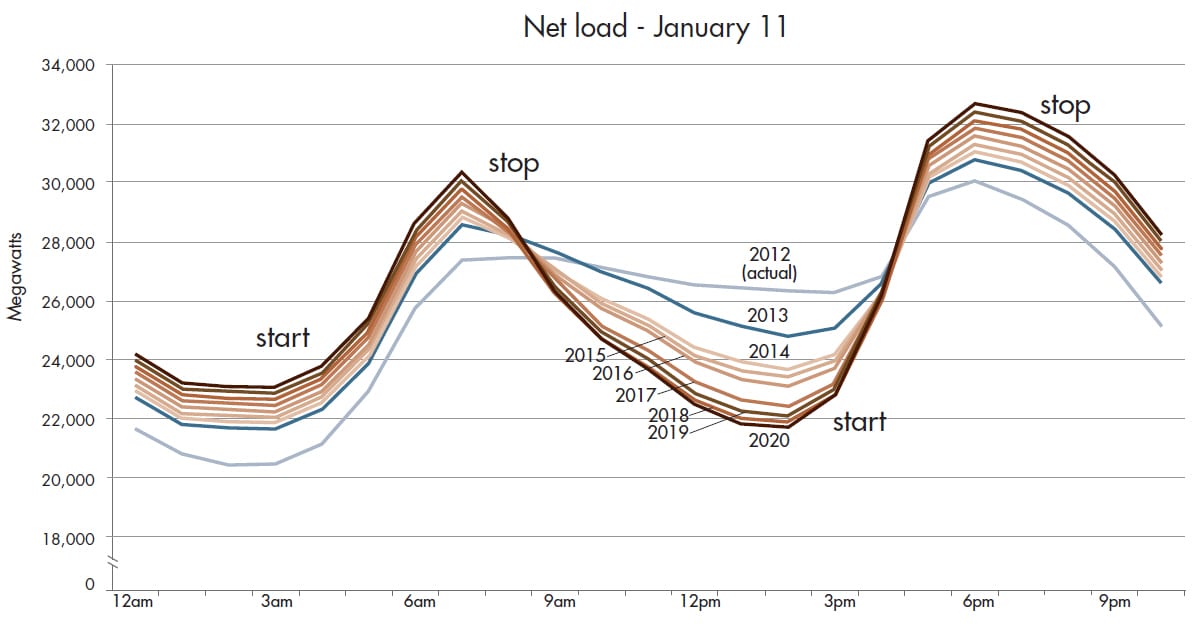Europe braces for unprecedented dip in solar generation during eclipse; US system operators take note
 Image Credit: NASA/Hinode/XRT
Image Credit: NASA/Hinode/XRT
The March 20 eclipse will remove up to 35 GW of solar power from European grids; ISO-NE watching closely as regional PV growth continues
An historic event will unfold overseas in late March. For the first time, operators of large, synchronized electric power systems will have to manage a potentially sizeable loss of generation caused by a solar eclipse. Starting the morning of March 20 at 7:40 Coordinated Universal Time (UTC), the output from Europe’s solar photovoltaic (PV) systems will drop off—then ramp up again—as the moon blots out the sun’s light in rolling two-hour periods across the area. Because Europe has such a large amount of installed solar generation, this will result in the temporary loss of potentially tens of thousands of gigawatts (GW) in total before the event finally ends at 11:50 UTC.
In the US, the phenomenon will play out between 3:40 a.m. and 7:50 a.m. Eastern Daylight Time. While the eclipse itself won’t be visible, power grid operators like ISO New England are paying close attention to developments. Solar power is growing rapidly in New England, and this event serves as a real-world example of how associated challenges can affect the reliable operation of the grid.
Effects on European systems
During Europe’s last eclipse in 1999, solar energy’s contribution to electricity generation was a small fraction of a percent. Even so, the United Kingdom’s National Grid reported it had to manage a 3,000 megawatt (MW) surge of demand when the eclipse ended and people resumed their normal routines—the largest surge it had recorded to date. (See “The ‘human-demand effect’” below.)
|
The total loss across Europe could be over 35,000 MW of installed capacity—the equivalent of about 80 medium-sized generators. |
Today, PV produces a noticeable 3% of total electricity in the continental European area alone—much more in some countries. And solar power has been expanding rapidly in the UK. The European Network of Transmission System Operators for Electricity (ENTSO-E) estimates that up to 33,501 MW of solar generation could fade across the continental European system during the eclipse. Germany alone will see 50% of that loss, with another 21% in Italy. In combination with National Grid’s projected loss of about 1,800 MW in the UK, the total loss across Europe could be over 35,000 MW of capacity—the equivalent of about 80 medium-sized generators, and more than the total capacity in all New England.
For the 2015 eclipse, Europe’s system operators have been coordinating closely for months on plans to successfully manage the swing in output, which is expected to change on the continental system at more than -400 MW per minute as the sun fades and +700 MW per minute as it re-emerges. ENTSO-E notes that “The main challenge… will be to coordinate the use of reserves in order to balance the power in real time without creating overloads on the grid.” Keeping system frequency stable is another concern. Insufficient generation can result in drops in frequency, meaning the system slows down; surplus electricity generation has the opposite effect. Such frequency changes can affect things like electric motors and sensitive system components.

Source: Solar Eclipse 2015—Impact Analysis,
ENTSO-E, February 19, 2015
Forecasting challenges
The sizable loss being planned for is a worst-case scenario, assuming that Europe will wake up to a clear, sunny day. If it’s overcast instead, total output from PV resources will be lower to begin with, meaning the dip will be less dramatic.
This uncertainty illustrates one of the central challenges of PV integration: it’s currently hard to accurately predict cloud cover, which determines the amount of sunlight hitting solar arrays—and therefore their output. That’s why government agencies and electricity industry organizations around the globe are working to improve solar forecasting.
In addition, how much of the sun the moon will cover will vary widely by region, with over 80% of the sun’s area obscured in Denmark, and as little as 25% in Turkey.
The “human-demand effect”
Adding to cloud cover, another factor that could “dampen the dip” is what ENTSO-E terms the human-demand effect: when there’s an eclipse, people typically stop what they’re doing and watch. This depresses demand for electricity as solar energy fades and increases it as the solar energy ramps back up. Based on previous eclipses, the human-demand effect could help counter-balance the eclipse—and potentially even cause a greater change in the opposite direction on the UK system, with its smaller share of PV.
Solar power in New England
As PV resources quickly proliferate across New England, the ISO will look to lessons learned in Europe during this and future solar events. Projections from the ISO’s most recent long-term PV forecasting efforts show installed regional PV capacity at approximately 910 MW through 2014, with roughly twice as much possible in August 2017 when a solar eclipse will traverse the US. That trajectory, in combination with the growing but still relatively small about of PV, is unlikely to cause a meaningful regional dip in generation. However, other noticeable effects of PV on the grid aren’t far off; ISO New England is already starting to see how PV can reshape the demand curve, as described by California ISO’s “duck curve,” shown below.

Source: “Fast Facts: What the duck curve tells us about
managing a green grid,” California ISO, 2013
Precisely balancing the amount of supply with consumer demand is both an art and a science, but it’s nothing new for New England grid operators—they do it every day to ensure that the lights stay on. (View this system load graph to see the current forecasted demand for power versus actual real-time demand.) ISO system operators are also familiar with managing the grid through situations where electricity demand rapidly dips and spikes—such as the Super Bowl.
For more information
- Read “Growth in solar energy means changes for power grid planning, operations” to learn more about PV in New England and how the ISO is helping with forecasting research in the US.
- Learn more about the resource mix in New England and how the region is working toward a smarter, greener grid.
- See “Super Bowl Sunday and its effect on the power grid” to learn more about the demand-forecasting process and how the ISO manages grid operations during extraordinary demand situations.
- Categories
- Inside ISO New England
- Tags
- renewable resources, solar, system operations
